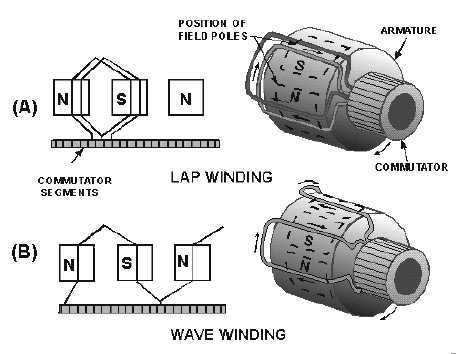1-15
Drum-type armatures are wound with either of two types of windings — the LAP WINDING or the
WAVE WINDING.
The lap winding is illustrated in figure 1-14, view A This type of winding is used in dc generators
designed for high-current applications. The windings are connected to provide several parallel paths for
current in the armature. For this reason, lap-wound armatures used in dc generators require several pairs
of poles and brushes.
Figure 1-14.—Types of windings used on drum-type armatures.
Figure 1-14, view B, shows a wave winding on a drum-type armature. This type of winding is used
in dc generators employed in high-voltage applications. Notice that the two ends of each coil are
connected to commutator segments separated by the distance between poles. This configuration allows
the series addition of the voltages in all the windings between brushes. This type of winding only requires
one pair of brushes. In practice, a practical generator may have several pairs to improve commutation.
Q16. Why are drum-type armatures preferred over the Gramme-ring armature in modern dc
generators?
Q17. Lap windings are used in generators designed for what type of application?
FIELD EXCITATION
When a dc voltage is applied to the field windings of a dc generator, current flows through the
windings and sets up a steady magnetic field. This is called FIELD EXCITATION.
This excitation voltage can be produced by the generator itself or it can be supplied by an outside
source, such as a battery. A generator that supplies its own field excitation is called a SELF-EXCITED
GENERATOR. Self-excitation is possible only if the field pole pieces have retained a slight amount of
permanent magnetism, called RESIDUAL MAGNETISM. When the generator starts rotating, the weak
residual magnetism causes a small voltage to be generated in the armature. This small voltage applied to



